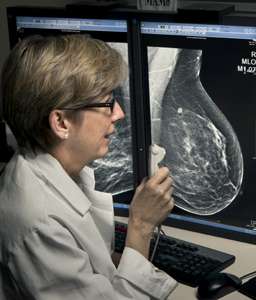3D mammography increases cancer detection and reduces call-back rates, study finds

Compared to traditional mammography, 3D mammography—known as digital breast tomosynthesis—found 22 percent more breast cancers and led to fewer call backs in a large screening study at the Hospital of the University of Pennsylvania (HUP), researchers reported today at the annual meeting of the Radiological Society of North America (RSNA).
Conventional digital mammography is the most widely-used screening modality for breast cancer, but may yield suspicious findings that turn out not to be cancer, known as false-positives. Such findings are associated with a higher recall rate, or the rate at which women are called back for additional imaging or biopsy that may be deemed unnecessary.
Tomosynthesis, however, allows for 3-D reconstruction of the breast tissue, giving radiologists a clearer view of the overlapping slices of breast tissue. And though a relatively new technology, it has shown promise at reducing recall rates in all groups of patients, including younger women and those with dense breast tissue. This study, presented by Emily F. Conant, MD, chief of Breast Imaging the department of Radiology at the Perelman School of Medicine at the University of Pennsylvania, is one of the largest prospective trials in tomosynthesis to date.
For the study, the research team compared imaging results from 15,633 women who underwent tomosynthesis at HUP beginning in 2011 to those of 10,753 patients imaged with digital mammography the prior year. Six radiologists trained in tomosynthesis interpretation reviewed the images.
Researchers found that, compared to conventional mammography, the average recall rate using tomosynthesis decreased from 10.40 percent to 8.78 percent, and the cancer detection rate increased from 4.28 to 5.24 per 1,000 patients, a 22 percent increase.
"Our study showed that we reduced our callback rate and increased our cancer detection rate," said Dr. Conant, the study's lead author. "The degree to which these rates were affected varied by radiologist. But importantly, the ratio of callback to cancer detection rate improved significantly for our radiologists."
The overall positive predictive value—the proportion of positive screening mammograms from which cancer was diagnosed—increased from 4.1 percent to 6.0 percent with tomosynthnesis, a 46% increase.
Since October 2011, all screening mammograms at Penn Medicine now include tomosynthesis, according to Dr. Conant.
"It's the most exciting improvement to mammography that I have seen in my career, even more important than the conversion from film-screen mammography to digital mammography," she said. "The coming years will be very exciting, as we see further improvements in this innovative technology."














